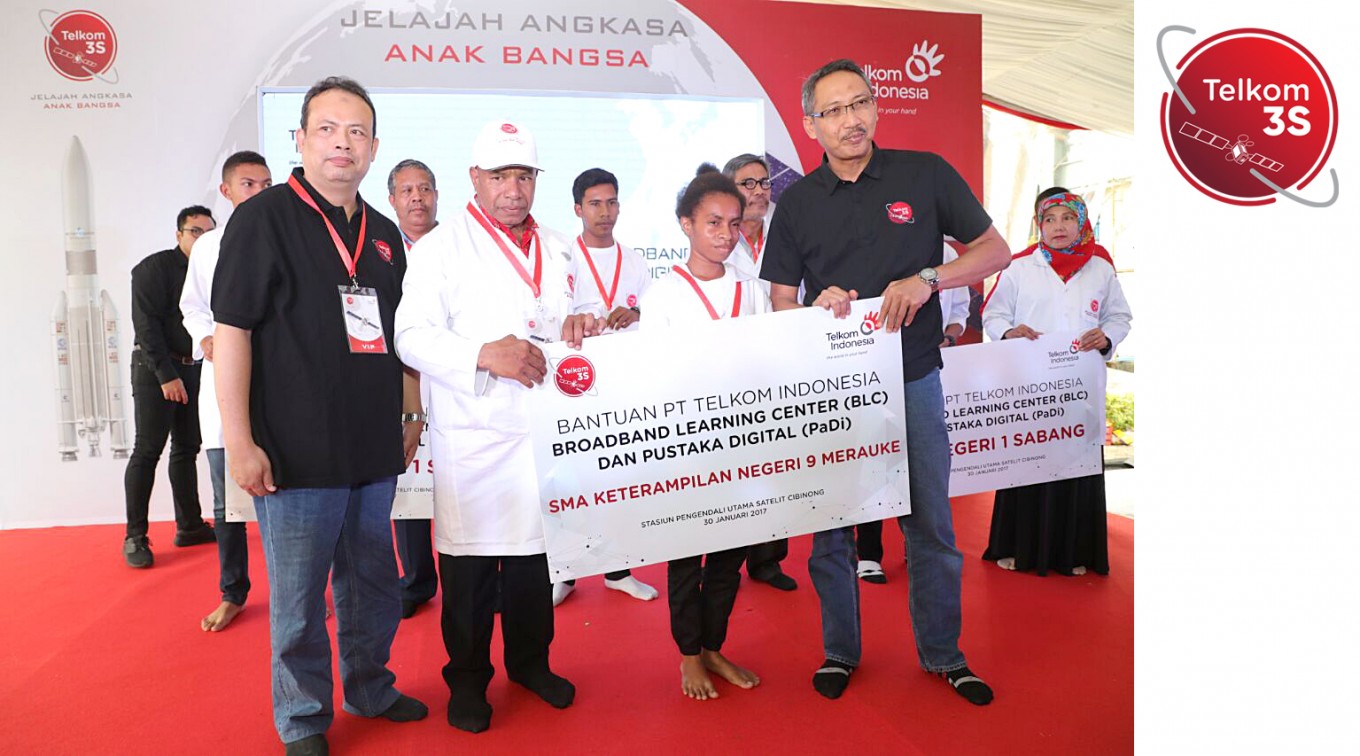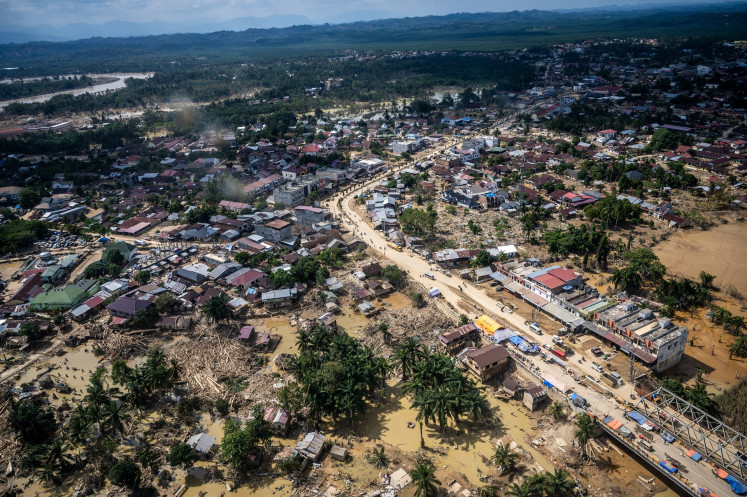Popular Reads
Top Results
Can't find what you're looking for?
View all search resultsPopular Reads
Top Results
Can't find what you're looking for?
View all search resultsTelkom’s $250m satellite to better connect Indonesia’s islands
Change text size
Gift Premium Articles
to Anyone
 Telkom’s Director of Network, IT & Solution, Abdus Somad Arief (right), and the senior general manager of the company’s Community Development Center, M. Sulthonul Arifin (left), pose for a picture after handing over Broadband Learning Center (BLC) and Pustaka Digital (PaDi) kits to SMP Keterampilan Negeri 9 Merauke, as the representative of aid recipients from the 3T regions (the frontier, outermost and remote regions) during the Young Indonesian Space Explorer study tour in Cibinong on Jan. 30. (-/-)
Telkom’s Director of Network, IT & Solution, Abdus Somad Arief (right), and the senior general manager of the company’s Community Development Center, M. Sulthonul Arifin (left), pose for a picture after handing over Broadband Learning Center (BLC) and Pustaka Digital (PaDi) kits to SMP Keterampilan Negeri 9 Merauke, as the representative of aid recipients from the 3T regions (the frontier, outermost and remote regions) during the Young Indonesian Space Explorer study tour in Cibinong on Jan. 30. (-/-)
C
lose to the equator, French Guiana, a scarcely populated country with only 158,000 inhabitants, is regarded as an ideal place to launch satellites. Mostly covered by equatorial forest, the South American country provides a stable climate, as well as invulnerability to earthquakes and hurricanes. Lying just over 500 km north of the equator, Kourou provides an advantage for satellite launches, because the earth’s spinning boosts the propulsion of the rocket taking the satellite into space.
In this part of Guiana, where a joint French and European spaceport has been built, Indonesia’s biggest telecommunication company Telekomunikasi Indonesia (Telkom) is set to release its latest satellite into space early in the morning of Feb. 15, Jakarta time. Called the Telkom 3S, the firm’s third satellite, which costs up to Rp 3.33 trillion (US$250 million), will provide high-definition television services, faster mobile communications and internet applications across the sprawling Indonesian archipelago of more than 17,000 islands, reaching primarily to the most remote areas.
This will be enabled by new technology, high-frequency Kuband transponders, which will cut installation time and allow faster connections.
“Unlike Telkom 1 and Telkom 2 Telkom 3S has Ku-band. The benefit is that the dishes [needed to receive signals] are smaller,” Telkom satellite project head Tonda Priyanto said on Sunday in Kourou.
Indonesia has long struggled with poor information and communication technology infrastructure despite the fact that many of its citizens are already highly tech-savvy.
The current administration kicked off late last year its ambitious Palapa Ring project in a bid to connect all areas nationwide through its fiber-optic network.
However, only around one third of Indonesia’s area can be covered by terrestrial communications systems, leaving the rest to be linked through satellite systems.
A McKinsey report released last September revealed that Indonesia could realize growth of an estimated 10 percent in the gross domestic product (GDP), equivalent to $150 billion, by 2025.
“The need for satellite technology is absolute in Indonesia. Meanwhile, the supply is still low,” Telkom chief technology officer Abdus Somad Arief recently said.
(Read also: Telkom 3S set to launch on Valentine’s Day)
Overall, the Telkom 3S satellite will carry 49 transponders, adding to the 140 transponders that Telkom currently operates through its two orbiting satellites.
Satellite builder Thales Alenia Space has handled the design, testing and in-orbit delivery of the satellite, while the satellite launch company Arianespace will be in charge of releasing the satellite into space.
During the planned launch, Telkom 3S will be positioned at 118 degrees east, to replace Telkom 2. Telkom 2, which still has a life span of about four years, will be moved to another orbital position.
In response to the satellite launch, Communications and Information Minister Rudiantara said the Telkom 3S satellite would definitely help meet the demand for better network quality in Indonesia.
“I think that even if the government begins launching its own satellites, we will still be at a deficit even up to the year 2023,” he said. “What the government can do in the meantime is to give satellite lending rights to local companies to avoid dependence on foreign ones.”








